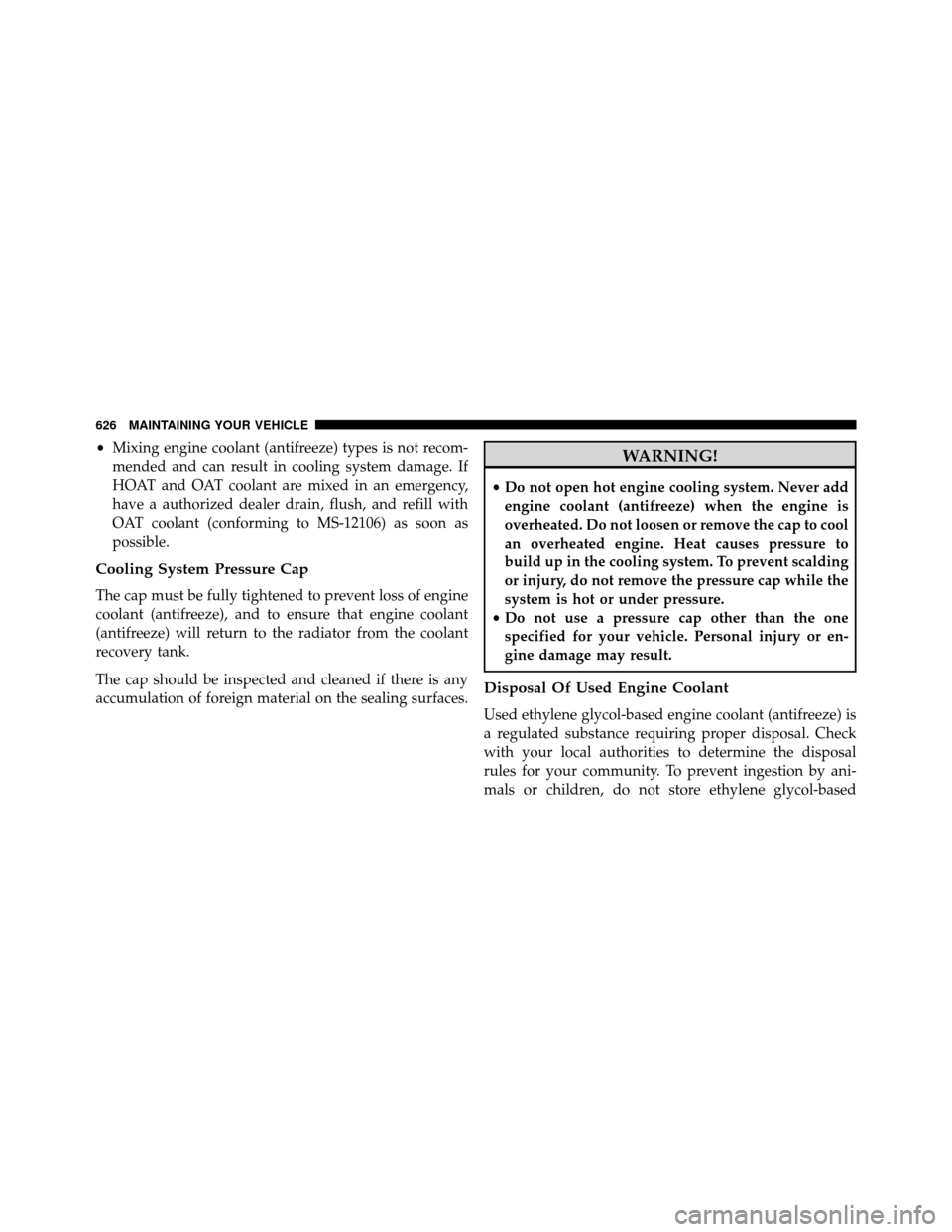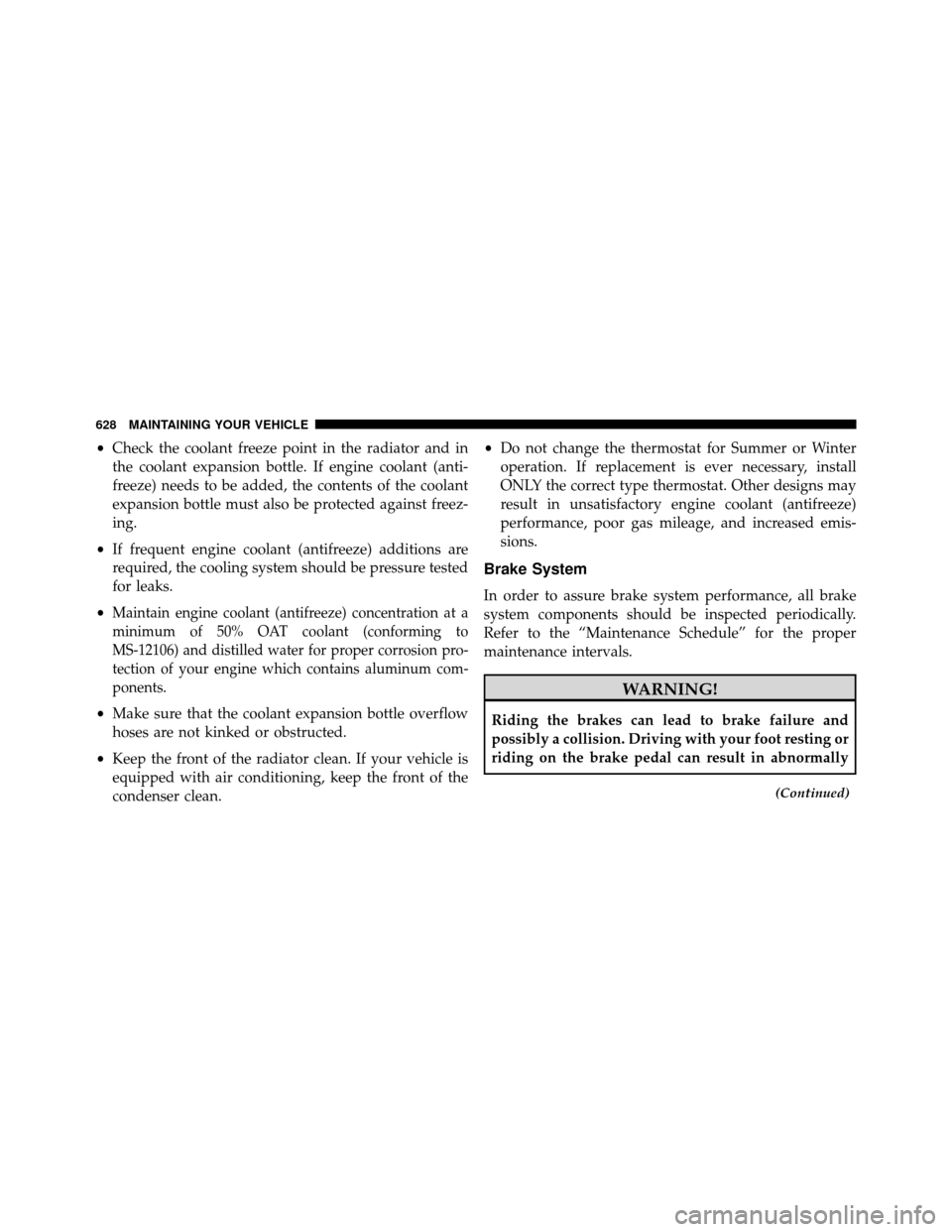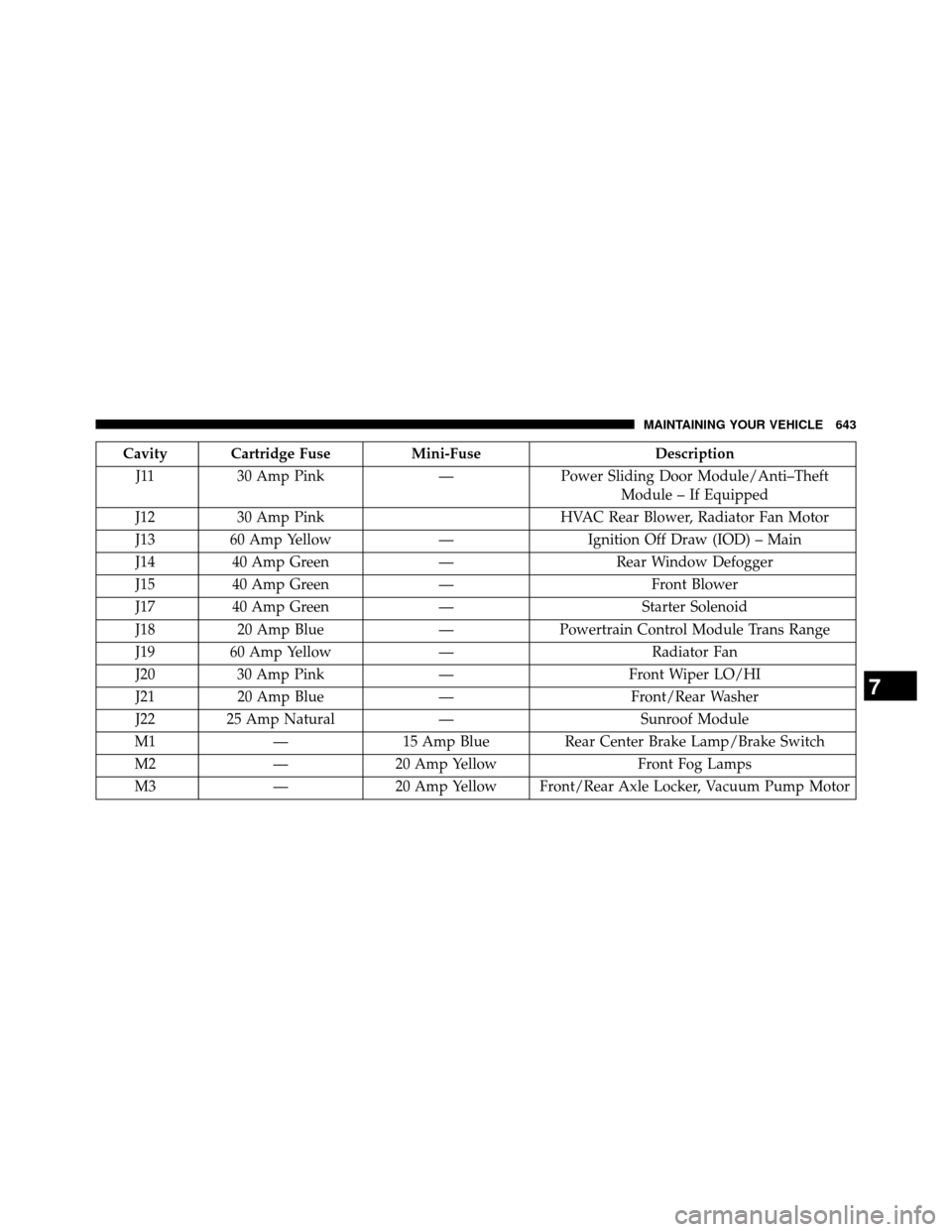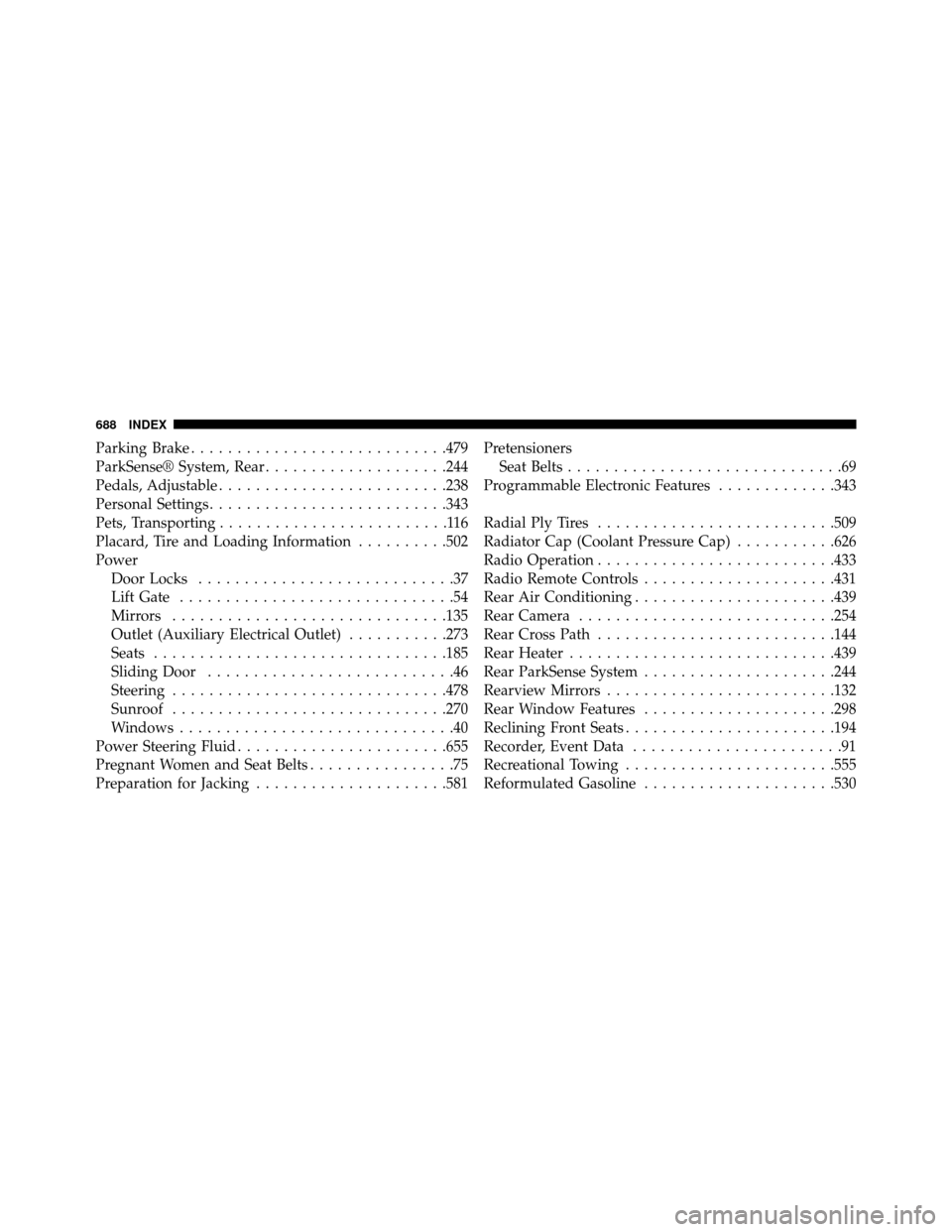2014 DODGE GRAND CARAVAN radiator
[x] Cancel search: radiatorPage 628 of 698

•Mixing engine coolant (antifreeze) types is not recom-
mended and can result in cooling system damage. If
HOAT and OAT coolant are mixed in an emergency,
have a authorized dealer drain, flush, and refill with
OAT coolant (conforming to MS-12106) as soon as
possible.
Cooling System Pressure Cap
The cap must be fully tightened to prevent loss of engine
coolant (antifreeze), and to ensure that engine coolant
(antifreeze) will return to the radiator from the coolant
recovery tank.
The cap should be inspected and cleaned if there is any
accumulation of foreign material on the sealing surfaces.
WARNING!
• Do not open hot engine cooling system. Never add
engine coolant (antifreeze) when the engine is
overheated. Do not loosen or remove the cap to cool
an overheated engine. Heat causes pressure to
build up in the cooling system. To prevent scalding
or injury, do not remove the pressure cap while the
system is hot or under pressure.
• Do not use a pressure cap other than the one
specified for your vehicle. Personal injury or en-
gine damage may result.
Disposal Of Used Engine Coolant
Used ethylene glycol-based engine coolant (antifreeze) is
a regulated substance requiring proper disposal. Check
with your local authorities to determine the disposal
rules for your community. To prevent ingestion by ani-
mals or children, do not store ethylene glycol-based
626 MAINTAINING YOUR VEHICLE
Page 629 of 698

engine coolant in open containers or allow it to remain in
puddles on the ground. If ingested by a child or pet, seek
emergency assistance immediately. Clean up any ground
spills immediately.
Coolant Level
The coolant bottle provides a quick visual method for
determining that the coolant level is adequate. With the
engine OFF and cold, the level of the engine coolant
(antifreeze) in the bottle should be between the ranges
indicated on the bottle.
The radiator normally remains completely full, so there is
no need to remove the radiator/coolant pressure cap
unless checking for engine coolant (antifreeze) freeze
point or replacing coolant. Advise your service attendant
of this. As long as the engine operating temperature is
satisfactory, the coolant bottle need only be checked once
a month.
When additional engine coolant (antifreeze) is needed to
maintain the proper level, only OAT coolant that meets the
requirements of Chrysler Material Standard MS-12106
should be added to the coolant bottle. Do not overfill.
Points To Remember
NOTE:When the vehicle is stopped after a few miles/
kilometers of operation, you may observe vapor coming
from the front of the engine compartment. This is nor-
mally a result of moisture from rain, snow, or high
humidity accumulating on the radiator and being vapor-
ized when the thermostat opens, allowing hot engine
coolant (antifreeze) to enter the radiator.
If an examination of your engine compartment shows no
evidence of radiator or hose leaks, the vehicle may be
safely driven. The vapor will soon dissipate.
• Do not overfill the coolant expansion bottle.
7
MAINTAINING YOUR VEHICLE 627
Page 630 of 698

•Check the coolant freeze point in the radiator and in
the coolant expansion bottle. If engine coolant (anti-
freeze) needs to be added, the contents of the coolant
expansion bottle must also be protected against freez-
ing.
• If frequent engine coolant (antifreeze) additions are
required, the cooling system should be pressure tested
for leaks.
•
Maintain engine coolant (antifreeze) concentration at a
minimum of 50% OAT coolant (conforming to
MS-12106) and distilled water for proper corrosion pro-
tection of your engine which contains aluminum com-
ponents.
• Make sure that the coolant expansion bottle overflow
hoses are not kinked or obstructed.
• Keep the front of the radiator clean. If your vehicle is
equipped with air conditioning, keep the front of the
condenser clean. •
Do not change the thermostat for Summer or Winter
operation. If replacement is ever necessary, install
ONLY the correct type thermostat. Other designs may
result in unsatisfactory engine coolant (antifreeze)
performance, poor gas mileage, and increased emis-
sions.
Brake System
In order to assure brake system performance, all brake
system components should be inspected periodically.
Refer to the “Maintenance Schedule” for the proper
maintenance intervals.
WARNING!
Riding the brakes can lead to brake failure and
possibly a collision. Driving with your foot resting or
riding on the brake pedal can result in abnormally
(Continued)
628 MAINTAINING YOUR VEHICLE
Page 645 of 698

Cavity Cartridge FuseMini-FuseDescription
J11 30 Amp Pink —Power Sliding Door Module/Anti–Theft
Module – If Equipped
J12 30 Amp Pink HVAC Rear Blower, Radiator Fan Motor
J13 60 Amp Yellow —Ignition Off Draw (IOD) – Main
J14 40 Amp Green —Rear Window Defogger
J15 40 Amp Green — Front Blower
J17 40 Amp Green —Starter Solenoid
J18 20 Amp Blue —Powertrain Control Module Trans Range
J19 60 Amp Yellow — Radiator Fan
J20 30 Amp Pink —Front Wiper LO/HI
J21 20 Amp Blue —Front/Rear Washer
J22 25 Amp Natural —Sunroof Module
M1 —15 Amp Blue Rear Center Brake Lamp/Brake Switch
M2 —20 Amp Yellow Front Fog Lamps
M3 —20 Amp Yellow Front/Rear Axle Locker, Vacuum Pump Motor
7
MAINTAINING YOUR VEHICLE 643
Page 679 of 698

Adding Fluid..........................631
Fluid and Filter Changes ..................632
Fluid Change ..........................632
Fluid Level Check .......................631
FluidType ............................630
Gear Ranges ...........................466
Special Additives .......................631
Torque Converter .......................474
Auto Up Power Windows ....................43
Battery .................................616
Jump Starting ..........................593
Keyless Transmitter Replacement (RKE) ........28
Saving Feature (Protection) ................231
Belts, Seat ...............................121
Body Mechanism Lubrication .................620
B-Pillar Location ..........................501
Brake Assist System .......................485
Brake Control System, Electronic ..............484Brake Fluid
.............................655
Brake System ............................628
Fluid Check ...........................629
Parking ..............................479
Warning Light .........................322
Brake/Transmission Interlock .................464
Bulb Replacement .........................649
Bulbs,Light.............................124
Calibration, Compass ......................342
Camera, Rear ............................254
Capacities, Fluid ..........................653
Caps, Filler Fuel .................................538
Power Steering .........................478
Radiator (Coolant Pressure) ................626
Carbon Monoxide Warning ..................120
Cargo Area Features .......................297
Cargo Compartment .......................297
10
INDEX 677
Page 681 of 698

Console, Overhead........................256
Console, Removable .......................294
Contract, Service ..........................669
Coolant Pressure Cap (Radiator Cap) ...........626
Cooling System ...........................622
Adding Coolant (Antifreeze) ...............624
Coolant Capacity .......................653
Coolant Level ..........................622
Disposal of Used Coolant .................626
Drain, Flush, and Refill ...................623
Inspection ............................627
Points to Remember .....................627
Pressure Cap ..........................626
Radiator Cap ..........................626
Selection of Coolant (Antifreeze) .............623
Corrosion Protection .......................632
Cupholders .............................279
Customer Assistance .......................667 Data Recorder, Event
.......................91
Daytime Running Lights ....................227
Dealer Service ............................609
Defroster, Windshield ......................122
Delay (Intermittent) Wipers ..................233
Diagnostic System, Onboard .................606
Dimmer Control ..........................228
Dipsticks Automatic Transmission ..................631
Oil (Engine) ...........................611
Power Steering .........................478
Disabled Vehicle Towing ....................600
Disposal Antifreeze (Engine Coolant) ................626
Door Locks Door Locks ............................35
KeyFob...............................35
Remote ...............................35
Remote Keyless Entry (RKE) ................35
10
INDEX 679
Page 690 of 698

Parking Brake............................479
ParkSense® System, Rear ....................244
Pedals, Adjustable .........................238
Personal Settings ..........................343
Pets, Transporting .........................116
Placard, Tire and Loading Information ..........502
Power Door Locks ............................37
Lift Gate ..............................54
Mirrors ..............................135
Outlet (Auxiliary Electrical Outlet) ...........273
Seats ................................185
Sliding Door ...........................46
Steering ..............................478
Sunroof ..............................270
Windows ..............................40
Power Steering Fluid .......................655
Pregnant Women and Seat Belts ................75
Preparation for Jacking .....................581 Pretensioners
Seat Belts ..............................69
Programmable Electronic Features .............343
Radial Ply Tires ..........................509
Radiator Cap (Coolant Pressure Cap) ...........626
Radio Operation ..........................433
Radio Remote Controls .....................431
Rear Air Conditioning ......................439
Rear Camera ............................254
Rear Cross Path ..........................144
Rear Heater .............................439
Rear ParkSense System .....................244
Rearview Mirrors .........................132
Rear Window Features .....................298
Reclining Front Seats .......................194
Recorder, Event Data .......................91
Recreational Towing .......................555
Reformulated Gasoline .....................530
688 INDEX